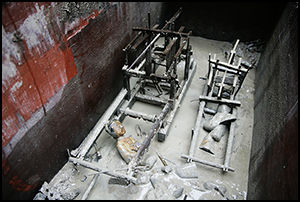In the second century most parts of the world were fairly underdeveloped in terms of technology and science, especially when you compare these civilizations to that of the scientifically advanced ancient China. Not only were several important tools and technologies invented in ancient China, but many of the belief systems and theories we still apply to our art were invented as well. Many discoveries were made in China before western scientists or philosophers made them, for example, camera obscura was first discovered by scientists in fourth century China, which was earlier than the discovery made in Greece. Inventions made in ancient china ranged from strong scientific breakthroughs, like the discovery of camera obscura, to artistic movements and theories of art and philosophy like Feng Shui.

When archeologists excavated a Han dynasty burial site in 2013 they found remains of a wooden pattern loom. This my be the earliest pattern loom scientists have discovered. Not only does this discovery show how developed the east was, but it shows us that the ancient Chinese thought beautiful textiles were important enough for a loom to be at the emperors burial site. The importance of a pattern loom does make sense, however, when one considers the fact that the Han dynasty burial site would have been in use and in construction during the second century, right around the time the silk road was opened. With the demand for silk from the west it must have become clear how valuable fine silks were. So, not only does this discovery show us how incredibly advanced China was in the second century, but it also reveals how important art and textiles were.

The symbolism of certain artistic elements were so important that there was, and still is (though not nearly to as great an extent), a colour system for not only clothing and costumes, but for paintings, ceramics and other fine arts as well. Each dynasty had its distinct colour which was usually worn on officials robes and featured in banners and flags. for example, the Han dynasty colours were purple and blue. Each dynasty was associated with a dynastic colour which was connected to one of the five elements, on which this colour system was based. The five main colours were red (celebration, a lucky colour), yellow (the national colour and the colour of emperors), green and blue (growth and life itself), white (purity and mourning) and black (death and criminality). Purple was an imperial colour, as was the case with many cultures at this time.

Ancient China was filled with rich traditions, incredible inventions and beautiful art. Many of the luxuries we enjoy today originated in China, and many of the beliefs about colours and the symbolism of this system are still embedded in current day Chinese culture.
Citations:
Yinke Deng. “Ancient Chinese Inventions.” Google Books, Cambridge University Press, New York, books.google.ca/books?hl=en&lr=&id=EeVPT6UAk3EC&oi=fnd&pg=PA1&dq=ancient chinese inventions&ots=PPzjtWbKBL&sig=HzLJD7FGdZ1ULQLqovujWdjna24&redir_esc=y#v=onepage&q=ancient chinese inventions&f=false.
“China Timeline.” Ancient History Encyclopedia, Ancient History Encyclopedia, www.ancient.eu/timeline/china/.
“Colors in Chinese Art 色 Sè.” Color Symbolism in Chinese Art, www.chinasage.info/symbols/colors.htm.
“Figure 2f from: Irimia R, Gottschling M (2016) Taxonomic Revision of Rochefortia Sw. (Ehretiaceae, Boraginales). Biodiversity Data Journal 4: e7720. Https://Doi.org/10.3897/BDJ.4.e7720.” doi:10.3897/bdj.4.e7720.figure2f.
Zhao, Feng, et al. “Mechanism of Laoguanshan Pattern Looms from Late 2nd Century BCE, Chengdu, China.” SpringerLink, Springer, Cham, 1 Jan. 1970, link.springer.com/chapter/10.1007/978-3-319-31184-5_19.
Zhao, Feng, et al. “The Earliest Evidence of Pattern Looms: Han Dynasty Tomb Models from Chengdu, China.” Cambridge Core, Cambridge University Press, 4 Apr. 2017, www.cambridge.org/core/journals/antiquity/article/earliest-evidence-of-pattern-looms-han-dynasty-tomb-models-from-chengdu-china/50DDD53B5889E6FF4C88FD75F0271C33/core-reader.